Posts Tagged ‘Rare coin’
Do you know how rare the Great Fire of London £2 really is?
With 37 different £2 coin designs in circulation, it’s very tough to choose a favourite, but one of mine is certainly the Great Fire of London £2, issued in 2016 to mark the 350th anniversary of one of the most well-known disasters to hit London.
The reverse of the coin, designed by Aaron West, depicts the city of London burning in flames from a distance and makes for an eye catching design which I’m sure many collectors love just as much as I do.
But are you lucky enough to have one of these coins in your collection?
Whilst this coin was previously considered ‘Less Common’ (as rated on our Scarcity Index), it has now been confirmed that the mintage figure for the Great Fire of London £2 was mistakenly listed and the coin is in fact rarer than we once thought…
Mintage Charts
To reflect the change to the Great Fire of London £2 coin’s mintage figure, we’ve updated our mintage charts to show you how rare this coin actually is compared to the other £2’s in circulation.

The Great Fire of London has actually jumped up 15 places on the mintage chart now that the correct figure of 1,625,000 has been confirmed.
The previous figure of 5,135,000 placed the coin in the middle of the pack, just slightly rarer than the Gunpowder Plot £2, however it can now be found amongst the London Underground £2 coins, nearer the top of the mintage chart.
Scarcity Index
These changes are also evident on our latest Scarcity Index update.
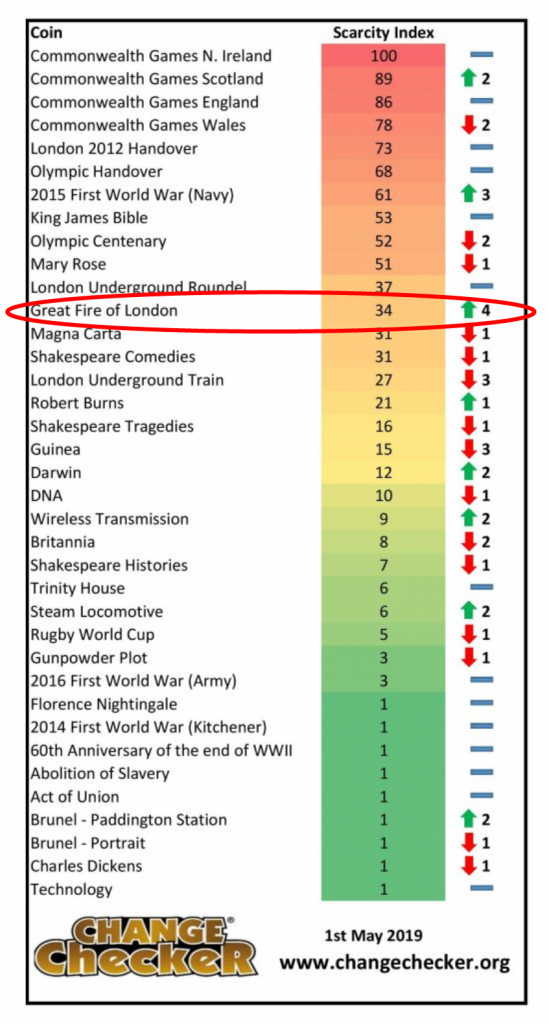
Whilst the coin has only moved up the index by 4 coin places, this is the biggest movement on the £2 index and the coin’s Scarcity Index score has actually jumped up from 18 to 34 – almost doubling from the previous index!
Historically, the Great Fire of London £2 has always scored in the mid to high teens, but the updated mintage figures now reflect the fact that the coin is in fact harder than previously believed to find in your change.
Have any other coins been affected?
It wasn’t just the Great Fire of London £2 coin which was affected by the updated mintage figures… There were in fact 4 coins from 2016 with previously incorrect figures.

The changes haven’t made much of an impact to either of these coin’s rankings for the Scarcity Index, with both coins actually moving down 1 place on the index pictured above.
With regards to our mintage figure charts, the two coins have simply swapped positions, as can be seen below.
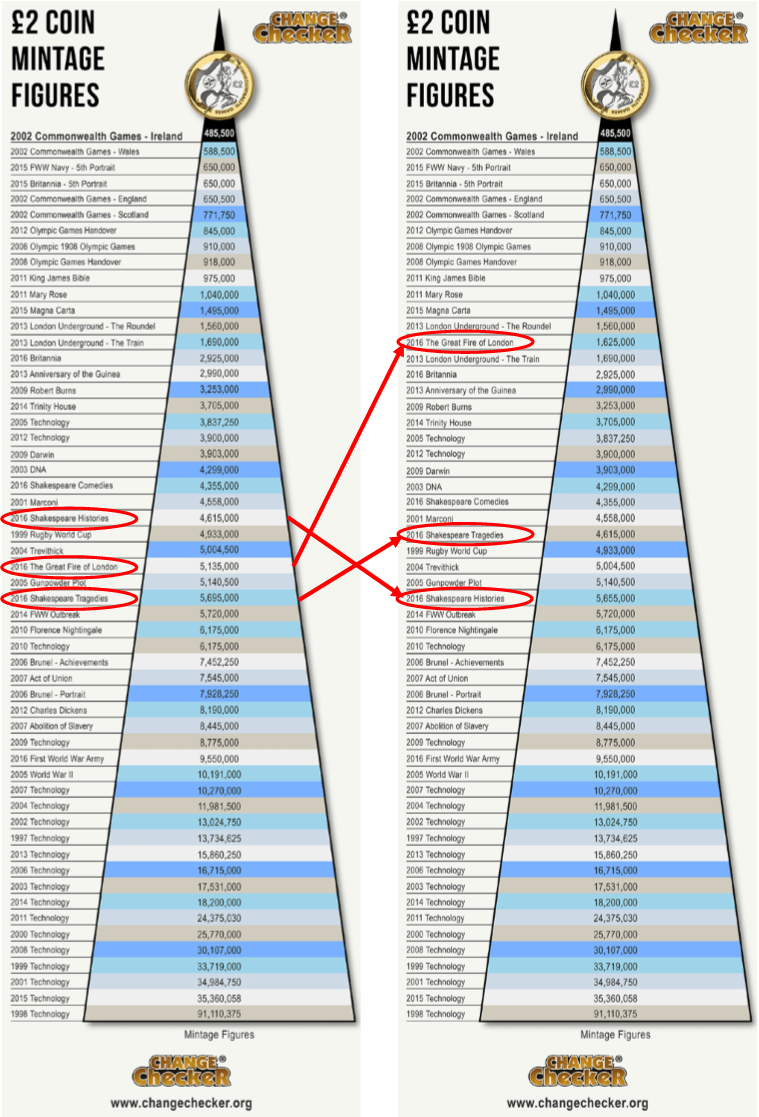
With regards to 50p coins, the only coin affected was the 2016 Peter Rabbit 50p.

This relatively small increase has had no effect on the coin’s ranking on the Scarcity Index or position on the mintage figure chart, which can be seen below.
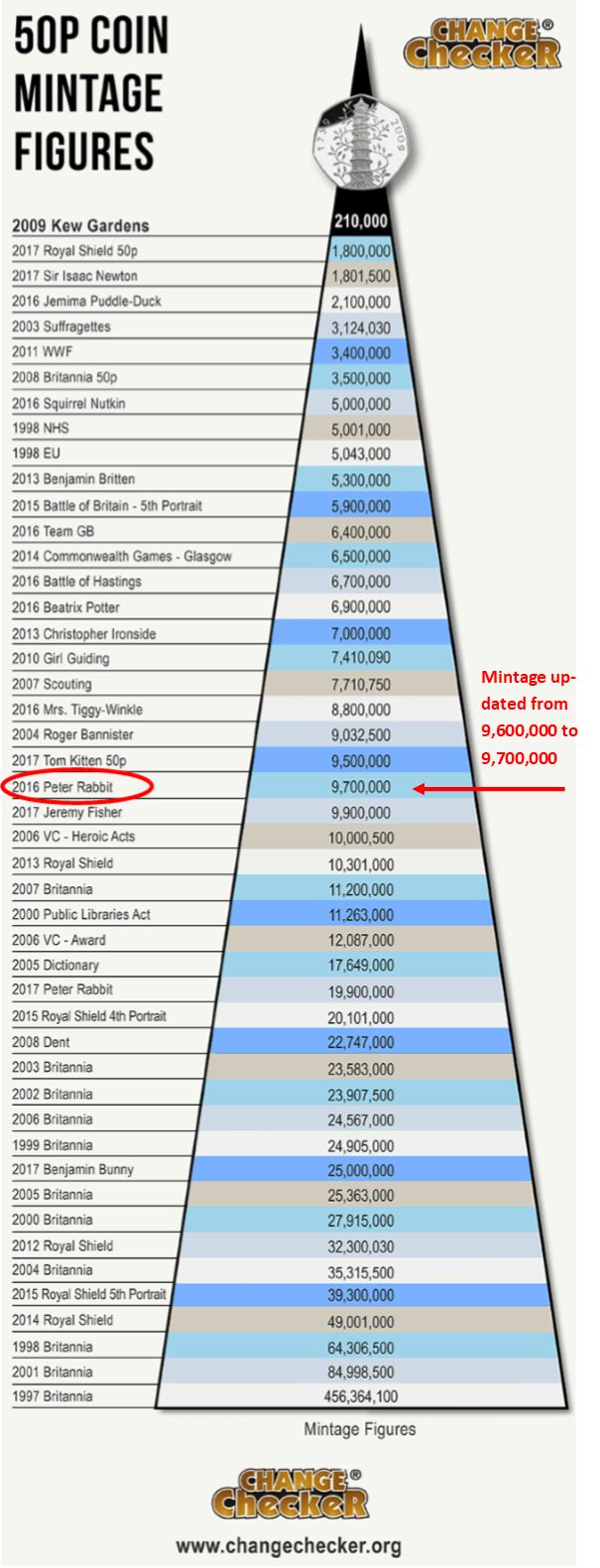
Whilst the changes to the mintage figures for the Shakespeare £2s and Peter Rabbit 50p have made minimal impact, it’s fair to say that with almost 4 million less Great Fire of London £2 coins in circulation than previously thought, the scarcity of this coin has definitely increased, making it even more special for those of you lucky enough to have one in your collection.
Add the Great Fire of London circulation £2 to your collection!
Following the updated mintage figures, I’m sure collectors will be keen to make sure this coin is added to their collection.
Click here to secure the coin in circulation quality for £8.00 with FREE p&p
Have I found a rare coin? £2 ‘errors’ explained!
So you’ve noticed something’s not quite right with the £2 coin you’ve just found in your change. A quick web search of the strange variation you’ve noticed shows a plethora of eBay listings and news articles claiming that you might have just hit the jackpot and your ‘error’ coin is worth a small fortune! But before you think about selling your coin, you should first find out a bit more about how these errors occur.
Read on to learn more about some of the mis-strikes found on £2 coins and how their bi-metallic quality causes the differences to be something entirely more spectacular than those found on monometallic (single metal) coins.
Striking bi-metallic coins
In order to understand why mis-strikes on bi-metallic coins are often more pronounced than monometallic coins, it’s first a good idea to look into how these coins are produced.
When striking £2 coins, the first step is to punch a hole through a blank planchet to create the outer section. The inner core is taken from a different metal, sized to fit inside the outer ring.
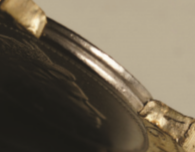
A groove is milled around the edge of the inner core so that when both parts are struck together, the metals will fuse as the outer ring deforms and spread into the groove, locking it into place.
Now that we know how £2 coins are struck, here are some of the mis-strikes and errors that can occur in the process…
Clipped Planchet

Image Credit: Coin News
This first example shows how the inner core was punched out from the end of the sheet of metal used for blanks, forming a straight or ragged edge clip.
Whilst this also occurs with monometallic coins, the pairing with an outer ring exposes a large gap which is much more noticeable.
The Royal Mint strike millions of coins each year, so it’s inevitable that variances will occur during the striking process and can’t always be picked up during quality control, despite the fact that this particular coin would weigh less than the standard 12g £2 coin. However, a small quantity of coins do sometimes manage to slip through the net and as I’m sure you’ll agree, they make for interesting collecting.
But before you pay over the odds for one of these coins, beware of fakers! Some coins are manipulated to look like mis-strikes or error coins and sold to unsuspecting buyers. Check the clipped planchet edge of the coin to see if it’s genuine by making sure the detail of the design fades away towards the edge rather than suddenly stopping, which would indicate the coin had been cut.

Off Centre Inner Core

Image Credit: Coin News
This image shows an inner core which hasn’t been aligned properly prior to being struck.
Due to the way the inner and outer core are struck together with the two metals being lined up and then fused together during striking, a misalignment will mean that the inner core spills into the outer ring, as seen in the image above. There might also be a gap between the two metals on the opposing join.
This mis-strike is thought to be fairly common on the bi-metallic 12 sided £1 coin as well as some of the Technology £2 coins and even foreign bimetallic coins, but have you ever spotted one in your change?
Faulty Outer Ring

Our next example shows a faulty planchet or outer ring, where the inner core is exposed.
In the image above, you can actually see the specific engineering design where the inner core is grooved to help the metal bond to the outer ring and fuse during striking.
Similar to the first mis-strike we looked at, this could be caused by a clipped planchet, this time created when the outer ring was punched, however coins like this may also be caused by tampering post striking, for example by fakers trying to replace the inner core of a £2 with another coin to pass off as a rare error.
The Holy Grail of Bi-metallic ‘Errors’

Image Credit: Coin News
This type of error is described as the Holy Grail of bimetallic ‘errors’ and is the result of the nickel-brass £2 blank not having the inner core section punched out before being struck.
This means that the £2 coin is made from one full piece of nickel-brass, completely contrasting the very notion of a bimetallic coin.
A 2007 monometallic £2 was verified by The Royal Mint and in the email confirming the mis-strike, it was mentioned that they had only seen 4-5 similar coins before.
This rare striking error is highly sought after and coins have achieved extraordinary prices in private sales and auctions.
Foreign Planchet

Image Credit: Coin News
Another £2 error that can occur is when it’s been struck on the wrong planchet – a blank normally used to strike a different coin.
As The Royal Mint strikes a huge quantity of coins for different denominations and even different countries, blanks can sometimes end up in the wrong striking chamber, creating a wrong or foreign planchet error.
This is actually down to human error rather than a mis-strike and the coins would normally be picked out during quality control, however some have been spotted in circulation, not only on the £2 coin, but on various different denominations across UK coins and world wide.
Other £2 ‘errors’ that are worth keeping your eyes peeled for!
2014 First World War Kitchener £2 – Missing denomination
This £2 coin was issued in 2014 to mark 100 years since the outbreak of the First World War. It features an image of Lord Kitchener who was a prominent figure on British government propaganda campaigns during the time.
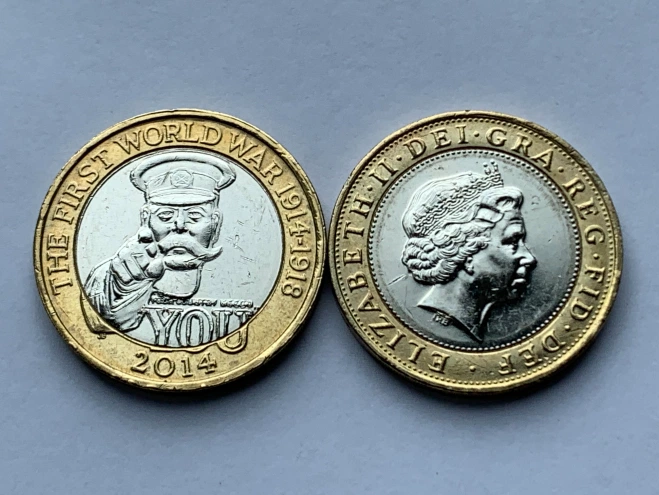
5,720,000 of these coins entered circulation, meaning it could be quite easy to stumble across one in your change. However, a small number of these coins are supposed to have entered circulation without the ‘Two Pounds’ denomination on the obverse.
Sometimes the denomination of the coin will feature on the reverse design, meaning it won’t appear on the obverse too. This can be seen on the Trinity House £2 coin which was issued earlier in the same year as the First World War £2.
It’s possible that the dies used to strike the obverse of the Trinity House £2 coin wasn’t replaced when the production of the First World War Centenary £2 coins began, resulting in the absence of a denomination.
We’ve only heard of two reports of these ‘error’ coins being found in circulation. However, Lockdales Auctioneers officiated the sale of the very first one back in March 2020 to the value of £500!
2015 First World War Navy £2 – ‘Flag’ error
When it was issued in 2015, the First World War Navy £2 coin caused a stir in the collecting world as it was revealed to be one of the rarest £2 coins, with just 650,000 struck for circulation.

The original Navy £2 design (above) shows the coin without any markings on the top right of the mast, but some eagle eyed collectors noticed that their £2 looked to have a flying flag.

As you can see from the two coins pictured above, the coin on the right looks like it has a flag atop the mast, whereas the first coin is free from any markings.
A number of people enquired about whether there were two different designs of the Navy £2 coin struck for circulation, however it was confirmed that the addition of the ‘flag’ was not intentional, and most likely caused by a cracked die.
So how much is my ‘error’ coin worth?
Whilst genuine error coins are out there and can be valuable, so too are a number of common mis-strikes and myths, or even fakes that have been manipulated to look like an error.
These coins certainly make for interesting collecting and the rarer variations, such as monometallic £2 coins could certainly sell for way over face value.
In fact, one such monometallic mis-strike found on a 2007 Technology £2 is estimated to be worth over £1,000!
Ultimately, as with all coins, it’s all down to how much an individual collector is willing to pay to add that coin to their collection, so we recommend checking out our 6 Point Guide to valuing your coins to determine it’s worth.
If you’ve found a £2 coin with a mis-strike, it’s also worth having it verified and authenticated by The Royal Mint, who will supply a letter detailing their findings.
So have you found any interesting variations on your bimetallic £2 coins? Let us know in the comments below!
With thanks to Scott Wren from Coin News.
Find out more about your coins
If you’re interested in coin collecting, our Change Checker web app is completely free to use!

Your Latest Scarcity Index Update!
How sought-after are your coins? Let’s find out with the latest Scarcity Index update!
We’re delighted to share with you the latest A-Z 10p, 50p and £2 coin indexes, with all the information you need to see how sought-after the coins in your collection really are.
This information has been compiled using data from the Change Checker Swap Centre (find out how it works here) and presented in the easy to use indexes below, with arrows to signify how many places up or down a coin has moved since the last Scarcity Index to help you track the performance of your coins.
A-Z 10p Scarcity Index

We’re now starting to see the A-Z 10p Scarcity Index stabilise as more data is gathered from the Change Checker web app to give a more accurate representation of how sought-after each design is.
K for King Arthur and S for Stonehenge remain at the top of the index and these along with F for Fish and Chips, Y for Yeoman Warder and R for Robin are the top 5 you’ll want to be looking out for.
Are you lucky enough to have any of these in your collection?
The biggest movement on the index is an 11 place drop going to P for Postbox, which is now amongst the 5 least scarce A-Z 10p coins.
V for Villages still remains at the bottom, but I for Ice Cream has jumped up 4 places to move out of the bottom 5 coins.
It’s important to note that the A-Z 10p Scarcity Index is currently based on estimated mintage figures, assuming each coin has been struck in equal quantities. This includes the extra 2.1 million coins released in 2019. It will certainly be interesting to see what happens to the index once the official mintage figures are confirmed.
50p Scarcity Index

We all know that the Kew Gardens is the UK’s most sought-after 50p and unless it’s revealed that another 50p has an even lower mintage figure, this won’t change and we’ll continue to see the Kew Gardens at the top of the 50p Scarcity Index.
There’s been some small movements amongst the Olympic 50ps which dominate the top end of the index, with some of the coins moving a few places here and there and the Gymnastics 50p actually increasing in scarcity by 5 places.
The scarcest of the non-Olympic commemorative 50ps is Jemima Puddle-Duck, who’s position remains unchanged for this update.
Despite having a lower mintage figure, the 2017 Sir Isaac Newton sits one position below Jemima Puddle-Duck on the index, making these two and the Kew Gardens the only three coins to break up the Olympic 50ps.
Volleyball has actually moved down the index by 7 places, making it the second least scarce Olympic 50p.
Team GB rose up the index by 9 places at the last index, but has now moved back down 11 places to sit in the bottom 5 least scarce 50p coins in circulation.
£2 Scarcity Index

As with the Kew Gardens 50p, the Commonwealth Games Northern Ireland continues to sit at the top of the index due to its incredibly low mintage figure.
The other Commonwealth Games £2 coins have had a small shuffle around, with Scotland taking the spot for second scarcest £2 in circulation.
The rest of the £2 index has only seen minor changes, which is to be expected as we haven’t seen new £2’s entering circulation since 2017.
However, one change to note is the Great Fire of London, which has moved 4 places up the index.
This is actually due to the updated mintage figures which reveal that whilst the coin was previously listed with a mintage of 5,135,000 there are actually only 1,625,000 of these coins in circulation. We’ve updated our mintage figure charts to reflect this, as well as the changes to the 2016 Peter Rabbit 50p, Shakespeare Histories and Shakespeare Tragedies £2 mintage figures.
How your Scarcity Index works
Generally collectors have had to rely upon mintage figures to identify the scarcest coins. But they only tell part of the story. Trying to find a good quality coin from 15 – 20 years ago, even for a higher mintage issue, is much more challenging than a more recent issue, as coins become damaged over time and are ultimately removed from circulation.
Additionally, some designs are more hoarded than others by people who might not normally collect coins – the poignant First World War £2 Coin series being an example. Finally, it can be up to a couple of years before the Royal Mint eventually confirms the actual mintage for an issue.
That’s why we have combined the mintage information with two other key pieces of information.
- How many of each design are listed as “collected” by Change Checkers, indicating the relative ease of finding a particular coin.
- The number of times a design has been requested as a swap over the previous 3 months, showing the current level of collector demand.
Importantly, as new coins are released and popularity rises and falls across different designs the Scarcity Index will be updated quarterly allowing Change Checkers to track the relative performance of the UK’s circulation coins.
How much are my coins worth?
The Scarcity Index does not necessarily equate to value but it is certainly an effective indicator. For example, the Kew Gardens 50p coin commands a premium of up to 200 times face value on eBay.
You can use the 6 point guide to help you determine a more realistic value for your coins.
What about £1 Coins?
The £1 Scarcity Index has already been published for the Round £1 coins and, because they are no longer being issued, this is now set in stone.
If you’re interested in coin collecting, our Change Checker web app is completely free to use and allows users to:
– Find and identify the coins in their pocket
– Collect and track the coins they have
– Swap their spare coins with other Change Checkers
Sign up today at: www.changechecker.org/app


